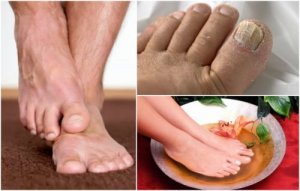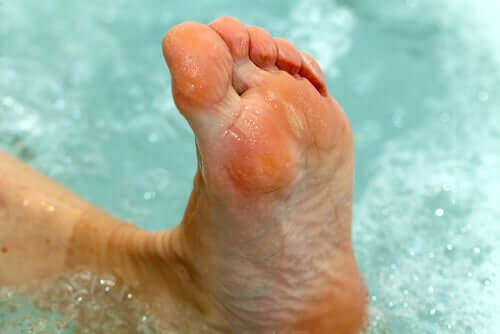Do You Have Symptoms of Foot Fungus?

Your feet are the perfect setting for fungus to grow and cause skin infections, especially when they’re often in moist or contaminated environments. Symptoms of foot fungus tend to come up as a result of neglecting this part of the body and they can be a very painful condition. Feet are an important body part but they’re often left out of people’s beauty routines.
The severity and type vary among individuals, and some may get it sporadically while others may deal with a reoccurring situation.
While it may not be a serious health issue, if it’s hard to treat it may be a sign of a weak immune system. In some cases, it even causes skin issues that then lead to cracking, burning, and other bothersome and painful symptoms.
That’s why it’s important to know how to identify it in a timely manner and, of course, treat it in a way that will send it packing for good.
What are the symptoms of foot fungus?
Foot fungi are infections that come from the growth of microorganisms in the skin.
They generally begin between the toes and move towards the sole of your foot and nails. They can cause various skin issues:
Some symptoms of foot fungus are:
- Excessive dryness
- Cracking
- Yellowish hard spots
- Burning sensation
- Itching
- Unpleasant odors
Read also:
What types of foot fungi are there?
There are two kinds of fungal infections that affect the feet.
Athlete’s foot, or tinea pedis
This is one of the most common infections. Because of how easily it spreads, it can be hard to treat if not detected on time.
It mainly affects athletes due to the heat and sweat inside their shoes during exercise, creating an ideal environment for the growth of fungus.

However, anybody can get it, especially if you don’t take preventative measures to avoid its growth on your feet and shoes.
Here are some symptoms of foot fungus that can help you distinguish it from other fungal infections:
- Your feet, especially between your fourth and fifth toes, are red.
- You feel burning and itching between your toes as well as on the soles of your feet.
- There are small cracks on your toes and sole.
- You see scabs or blisters on your skin.
- There is a strong odor, even after washing your feet.
Onychomycosis
Onychomycosis, a kind of nail fungus, is another fungal infection of the foot that is very common.
While it can also affect fingernails, it’s more common with toenails because of the moist, warm environment that wearing certain shoes creates.
Take note if you notice that your toenails:
- Turn yellowish or grayish.
- Crack or get white marks.
- Get too hard, especially with your big toe.
- Start to get deformed.
- Tend to break easily.
- Have a bad odor.
How do I fight a foot fungus?
Treating foot fungus depends on the severity of the infection.
However, generally speaking, it’s advisable to keep the skin dry and as well-ventilated as possible.
In addition, you can use natural remedies that will not only help control fungal growth but also relieve the itching and irritation.
Apple cider vinegar
Apple cider vinegar is acidic, and with its pH-regulating effect on your skin, it’ll help with fungal and bacterial infections.
Regular use gets rid of dead skin cells and fights the burning sensation.
- Add it to warm water and soak your feet for 20 minutes.
Check out:
Tea tree oil
Well-known for its anti-fungal and antibacterial properties, tea tree oil is an effective ingredient to fight infections.

- Add a small amount to warm water and soak your feet for 15 to 20 minutes.
- If the infection is in your nails, smooth it over the surface with a cotton ball.
Baking soda
The exfoliating and antiseptic effects of baking soda speed up the healing process of skin affected by fungus.
- Create a paste out of baking soda and water and rub it into your feet with gentle massaging motions.
- Let it sit for 10 minutes and then rinse.
Garlic
Garlic contains sulfuric compounds that give it anti-fungal and antibacterial powers.
- Mash one raw garlic clove and smooth the paste onto the areas affected by the fungus.
- Let it sit for 20 minutes and rinse.
Lemons
Fresh lemon juice is an effective way to fight feet and nail fungal infections.
Its natural acids regulate skin pH and alter the environment that these microorganisms need to grow.
- Apply the lemon juice to the affected areas and let it sit for 20 minutes.
Do you have any symptoms of foot fungus? If you just found out you do, try to take care of it as soon as possible so you don’t get complications. Use the remedies mentioned above and also wash your shoes and socks well to keep it from reappearing.
All cited sources were thoroughly reviewed by our team to ensure their quality, reliability, currency, and validity. The bibliography of this article was considered reliable and of academic or scientific accuracy.
- Braham, C., Ezzine-Sebai, N., Arrese, J. E., Piérard-Franchimont, C., & Piérard, G. E. (2001). The connection between sports and spores. The foot, its mycoses and onychomycoses. Revue Medicale de Liege.
- Azizjalali, M. H., & Behrangi, E. (2009). Study of the prevalence of tinea pedis in swimmers of the west pools of Tehran in 2007 [Farsi]. Journal of Iran University of Medical Sciences.
- Bottomley, A., & Veril, M. (1940). Sclerotium or footrot disease of Groundnuts. Fmg S Afr. 1940;
- VV.AA. (2003). El limón y sus componentes bioactivos. https://www.researchgate.net/publication/285695850_El_limon_y_sus_componentes_bioactivos
- Aller, R., De Luis, D.A. (2008).Ajo y riesgo cardiovascular.http://scielo.isciii.es/scielo.php?script=sci_arttext&pid=S0212-71992008000500010
- Yagnik, Darshna.,Serafin, Vlad.,Sha, Ajit. (2018).Antimicrobial activity of apple cider vinegar against Escherichia coli, Staphylococcus aureus and Candida albicans; downregulating cytokine and microbial protein expression.https://www.ncbi.nlm.nih.gov/pmc/articles/PMC5788933/
- VV.AA. (2012). Afectación ungueal de origen ocupacional.http://scielo.isciii.es/scielo.php?script=sci_arttext&pid=S0465-546X2012000400004
- Sanez de Santa María, María Luisa. (2011).Manifestaciones cutáneas de las enfermedades sistémicas.https://www.sciencedirect.com/science/article/pii/S0716864011704874
- VV.AA. (2010). Consideraciones actualizadas sobre la patogenia de la piña pedis. http://scielo.sld.cu/scielo.php?script=sci_arttext&pid=S1029-30192010000100015
- VV.AA. (2000).El prurito. Síntoma frecuente en la atención primaria de salud.http://scielo.sld.cu/scielo.php?script=sci_arttext&pid=S0864-21252000000400016
- Ballesté, Raquel., Mousqués, Nelida., Gezuele, Elbio. (2003). Onicomicosis, revisión del tema. http://www.scielo.edu.uy/scielo.php?script=sci_arttext&pid=S1688-03902003000200003
This text is provided for informational purposes only and does not replace consultation with a professional. If in doubt, consult your specialist.








